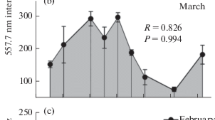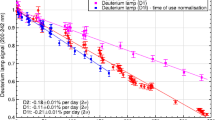Abstract
It is well known that the 630-nm nightglow emission intensity in midlatitudes increases by more than a factor of 2 during a sunspot maximum. It has been assumed that the phenomenon is caused by variations in solar UV radiation during a solar cycle (Fishkova, 1983).
We present the results of photometric measurements of the nightglow 630.0 nm emission intensity at a latitude of 63° E and longitude of 130° E (Yakutsk) in 1990–2007. The dependence of the 630-nm emission intensity on solar activity on magnetically quiet days in the 22nd and 23rd solar cycles is shown. The close relationship between the 630-nm nightglow intensity and the intensity of extreme UV (EUV) with a correlation coefficient of 0.8–0.9 in 1997–2007 is ascertained from the SOHO/SEM data. The dominance of solar EUV in the excitation of nightglow 630-nm emission has thus been experimentally proved.
Similar content being viewed by others
References
Barbier, D., Recherches Sur de la Raie 6300 Å de la Luminescence Atmospherique Nocturne, Ann. Geophys., 1959, vol. 15, no. 2, pp. 179–217.
Barbier, D., Les Variations D’intensite de la Raie 6300 Å de la Luminescence Nocturne, Ann. Geophys., 1961, vol. 17, no. 4, pp. 3–15.
Barbier, D., Variations de L’Intensite des Principales Radiations de la Luminescence Atmospherique Nocturne Avec le Cycle Solaire, Ann. Geophys., 1965, vol. 21, no. 3, pp. 265–274.
Chamberlain, J.W., Physics of the Aurora and Airglow, New York: Acad. Press, 1961. Translated under the title Fizika polyarnykh siyanii i izlucheniya atmosfery, Moscow: IIL, 1963.
Fishkova, L.M., Nochnoe izluchenie sredneshirotnoi verkhnei atmosfery Zemli (Nightglow of the Earth’s Midlatitude Upper Atmosphere), Tbilisi: Metsniereba, 1983.
Givishvili, G.V., Leshchenko, L.N., Lysenko, E.V., Perov, S.P., Semenov, A.I., Sergeenko, N.P., Fishkova, L.M., and Shefov, N.N., Long-Term Trends of Certain Characteristics of the Earth’s Atmosphere: Measurements, Izv. Akad. Nauk, Fiz. Atmos. Okeana, 1996, vol. 32, no. 3, pp. 329–339.
Hedin, Alan E., MSIS-86 Thermospheric Model, J. Geophys. Res., 1987, vol. 92A, pp. 4649–4662.
Ievenko, I.B., Absolyutnaya Energeticheskaya Graduirovka Spektrofotometrov Metodom Opornogo Priemnika. Metodicheskoe Rukovodstvo (Absolute Energy Calibration of Spectrophotometers Using the Reference Receiver Method: A Methodical Manual), Yakutsk: YaNTs SO RAN, 1995.
Ievenko, I.B., Effects of Magnetospheric Activity on the Plasmasphere as Inferred from Observations of Diffuse Aurorae and SAR Arcs, Geomagn. Aeron., 1999, vol. 39, no. 6, p. 26 [Geomagn. Aeron. (Engl. Transl.), 1999, vol. 39, p. 697–703].
Ievenko, I.B. and Alekseyev, V.N., Effect of the Substorm and Storm on the SAR Arc Dynamics: A Statistical Analysis, Geomagn. Aeron., 2004, vol. 44, no. 5, pp. 643–654 [Geomagn. Aeron. (Engl. Transl.), 2004, vol. 44, pp. 592–603].
Ievenko, I.B., Parnikov, S.G., and Alexeyev, V.N., Relationship of the Diffuse Aurora and SAR Arc Dynamics to Substorms and Storms, Adv. Space Res., 2008, vol. 41/8, pp. 1252–1260; doi:10.1016/j.asr.2007.07.030.
Mikhalev, A.V., Medvedeva, N.V., and Kostyleva, N.V., Manifestation of Solar Activity in Variations in the 557.7 and 630 nm Atmospheric Emissions in Cycle 23, Opt. Atmos. Okeana, 2008, vol. 2, no. 5, pp. 425–431.
Sahai, Y., Takahashi, H., Bittencourt, J.A., Sobral, J.H.A., and Teixeira, N.R., Solar Cycle and Seasonal Variations of the Low Latitude OI 630 nm Nightglow, J. Atmos. Terr. Phys., 1988, vol. 50, no. 2, pp. 135–140.
Shefov, N.N., Semenov, A.I., and Yurchenko, O.T., Empirical Model of Variations in the OI 630.0 nm Emission. 1. Intensity, Geomagn. Aeron., 2006, vol. 46, no. 2, pp. 250–260 [Geomagn. Aeron. (Engl. Transl.), 2006, vol. 46, pp. 236–246].
Truttse, Yu.L. and Belyavskaya, V.D., Red Oxygen Emission 630 Geomagn. Aeron., 1975, vol. 15, no. 1, pp. 101–104.
Author information
Authors and Affiliations
Corresponding author
Additional information
Original Russian Text © I.B. Ievenko, V.N. Alekseev, S.G. Parnikov, 2011, published in Geomagnetizm i Aeronomiya, 2011, Vol. 51, No. 5, pp. 702–707.
Rights and permissions
About this article
Cite this article
Ievenko, I.B., Alekseev, V.N. & Parnikov, S.G. Influence of the solar UV-radiation intensity on the 630-nm nightglow emission in the 23rd solar cycle. Geomagn. Aeron. 51, 688–693 (2011). https://doi.org/10.1134/S0016793211050069
Received:
Accepted:
Published:
Issue Date:
DOI: https://doi.org/10.1134/S0016793211050069




